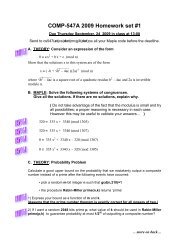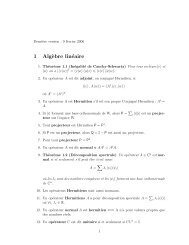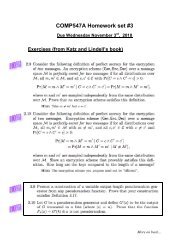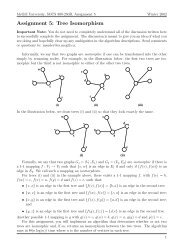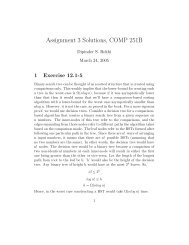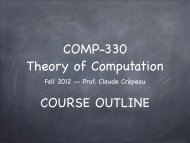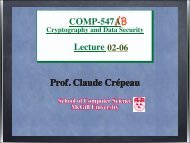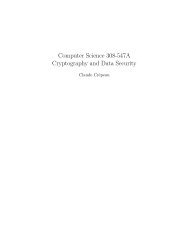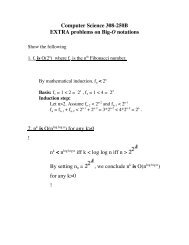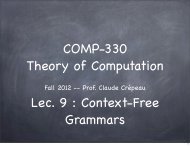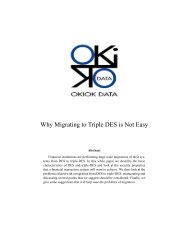COMP 547: Assignment 1 Solutions
COMP 547: Assignment 1 Solutions
COMP 547: Assignment 1 Solutions
You also want an ePaper? Increase the reach of your titles
YUMPU automatically turns print PDFs into web optimized ePapers that Google loves.
( ) ( )<br />
x<br />
x<br />
(b) If x ∈ QR p and x /∈ QR q , then<br />
p<br />
= 1 and<br />
q<br />
= −1. Using<br />
( ) ( ) ( ) ( )<br />
z<br />
z<br />
the facts that<br />
p<br />
= −1,<br />
q<br />
= 1 and y<br />
p<br />
= y<br />
q<br />
= −1,<br />
( ) ( ( ) ( )<br />
we see that zyx z<br />
p<br />
= y x<br />
p)<br />
p p<br />
= (−1)(−1)(1) = 1 and<br />
( ) ( ) ( ) ( )<br />
zyx z<br />
q<br />
= y x<br />
q q q<br />
= (1)(−1)(−1) = 1. From this, we can<br />
conclude that zyx ∈ QR n . ( ) ( )<br />
x<br />
x<br />
If x /∈ QR p and x ∈ QR q , then<br />
p<br />
= −1 and<br />
q<br />
= 1. Using<br />
( )<br />
( )<br />
( )<br />
z<br />
z<br />
zx<br />
the facts that<br />
p<br />
= −1 and<br />
q<br />
= 1, we see that<br />
p<br />
=<br />
( ) ( )<br />
( ) ( ) ( )<br />
z x<br />
zx z x<br />
p p<br />
= (−1)(−1) = 1 and<br />
q<br />
=<br />
q q<br />
= (1)(1) = 1.<br />
From this, we can conclude that zx ∈ QR n .<br />
Thus, regardless of how z was chosen, as long as it was chosen correctly,<br />
we can see that for each of our categories that an integer x ∈ X can fall<br />
into (in both QR p and QR q , QR p but not QR q , QR q but not QR p or<br />
neither QR p nor QR q ), either x, yx, zx or zyx is in QR n .<br />
Furthermore, there is a one-to-one correspondence between these occurrences.<br />
It is quite easy to show that if one of x, yx, zx or zyx is in<br />
QR n , then the other three ( possibilities ) ( ) are not in QR ( n ).<br />
For ( instance, ) ( )<br />
x x<br />
zx z x<br />
suppose x ∈ QR n . Then<br />
p<br />
=<br />
q<br />
= 1. Either<br />
p<br />
=<br />
p p<br />
=<br />
( ) ( ) ( )<br />
zx z x<br />
(−1)(1) = −1 or<br />
q<br />
=<br />
q q<br />
= (−1)(1) = −1, so zx /∈ QR n . Either<br />
( ) ( ( ) ( )<br />
( ) ( ) ( ) ( )<br />
zyx z<br />
p<br />
= y x<br />
p)<br />
p p<br />
= (1)(−1)(1) = 1 or zyx z<br />
q<br />
= y x<br />
q q q<br />
=<br />
) ( ) ( )<br />
(1)(−1)(1) = 1, so zyx /∈ QR n . = y<br />
p<br />
= (−1)(1) = −1, so<br />
(<br />
yx<br />
p<br />
yx /∈ QR p . The cases of yx, zx and zyx being in QR n can all be dealt<br />
with in a similar fashion.<br />
We have shown that if n, y and z were correctly chosen, we should obtain<br />
results similar to those we did, in fact, obtain: a somewhat even categorisation<br />
of the 100 integers in X into our four type categories. However,<br />
does the converse hold That is, if a more or less even categorisation of<br />
all the integers in X occurred, can we be certain that n, y and z were<br />
correctly chosen<br />
First, we note that it is easy to verify that ( (<br />
y<br />
n)<br />
= 1 and<br />
z<br />
n)<br />
= −1.<br />
This can be done by simply computing the Jacobi symbols in question.<br />
Therefore, in the rest of this discussion, we will assume that ( y<br />
) n)<br />
= 1 and<br />
= −1.<br />
( z<br />
n<br />
Now, suppose n has more than two prime factors, that is, n = p 1 · · · p k ,<br />
where k > 2. x ∈ QR n if and only if x ∈ QR p1 , . . . , x ∈ QR pk . Similarly,<br />
yx ∈ QR n if and only if yx ∈ QR p1 , . . . , yx ∈ QR pk , zx ∈ QR n if and<br />
only if zx ∈ QR p1 , . . . , zx ∈ QR pk and zyx ∈ QR n if and only if zyx ∈<br />
QR p1 , . . . , zyx ∈ QR pk . Intuitively, it is quite clear that in this case, there<br />
will be some integer x ∈ X such that neither x, yx, zx nor zyx is in QR n .<br />
x<br />
p<br />
28



